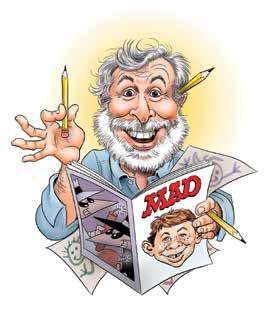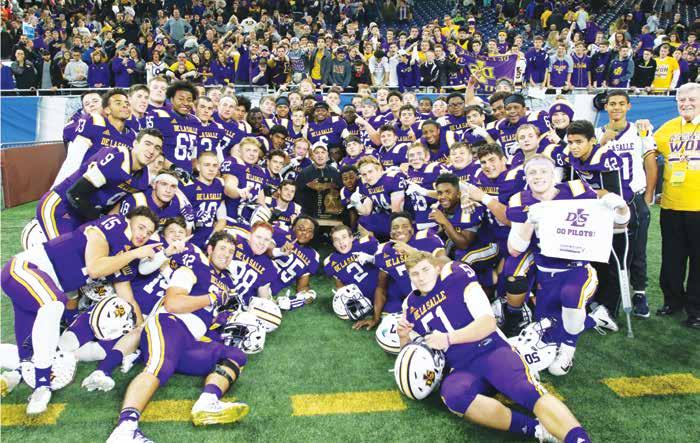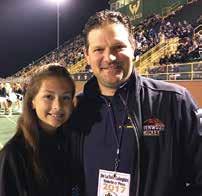
8 minute read
Alumni Spotlight
Frank Viviano, Class of 1965 Sam Viviano, Class of 1971
Brothers Frank and Sam Viviano both attended De La Salle Collegiate, both attended the University of Michigan, and both have fulfilled childhood dreams. Frank’s dream began as a 10-year old, with a subscription to National Geographic. He wanted “to grow up and travel all over the world, and write about people in foreign countries.” Younger brother Sam loved comic books, and aimed to be a cartoonist for Mad magazine.
Frank Viviano
Frank says his parents believed in Catholic education and wanted their sons to attend De La Salle. “They wanted us to go to a school that would make demands. They took seriously the motto Builders of Boys, Makers of Men.” Frank also noted the role of De La Salle in educating the children and grandchildren of immigrants. “In the 1960’s, we were almost all first or second generation. We were often the first in our families to go to college. DLS gave these working class children an opportunity to become part of the middle and professional class and to have meaningful careers.” Frank graduated from the University of Michigan in 1969, and completed a Ph.D. in American Studies in 1977, also at Michigan. His career in journalism and as a foreign correspondent began in 1977. He has been a witness to some of the most important historical events in our lifetimes: the overthrow of the dictator Ferdinand Marcos in the Philippines in 1986; the protests in Tiananmen Square, Beijing in 1989; the collapse of the Soviet Union in 1991. He has seen war in the Middle East and the Balkans. His work has appeared in more than 200 newspapers and magazines, and he is an 9-time Pulitzer Prize nominee. “I haven’t won, but would love to have that.” He is most proud of his work tracking human trafficking from China to Europe. “It is such a heinous crime. I was trying to unlock their methods and their financing and how they pulled it off. If those articles helped law enforcement authorities look for these guys or somehow brought people to their senses in those countries where young women and children are trafficked - that would be my greatest accomplishment.” And he is an author with seven books published in 14 countries. But war has wearied him. “The war in Iraq was tough. I needed some time off. I thought I’d do travel writing for a while, but even that got me kidnapped. I was kidnapped in Guatemala by the drug mafia. In 2012, I was kidnapped by angry tribesmen in western Burma. Trying to get away from war was not as easy as I thought.” It was getting away from war that led Frank to Italy. “I was in Bosnia, and to get away, I’d hitch a ride on a tank and spend a little time in Italy.” These days, Frank lives in northern Italy, where until recently
he owned a 900-year old, 17-room former convent in
Frank Viviano on assignment for National Graphic at the height of the war, interviewing young Iraqi soldiers, out of uniform, trying desperately to find a way out of Mosul before its defenses collapsed. (Photo by Ed Kashi)
Alumni Spotlight
Tuscany, renting rooms to tourists. Although his family has Sicilian roots, he has many connections in northern Europe, and found the location more convenient for travel. Two years ago, National Geographic asked him if he would be interested in doing archaeology. “I fell in love with National Geographic in 1957, reading about Egyptian mummies and Mayan pyramids. I am doing exactly what I wanted to do when I was a ten-year old boy.’ His article on Pompeii, the ancient Italian city covered by a volcano in 79 A.D., appeared in the April 2016 National Geographic. His most recent National Geographic article appeared in September 2017, a piece on sustainable farming in the Netherlands. His January 2006 article on the Kurds remains one of his most popular pieces. Frank bemoans the proliferation of unchecked news sources. “Today the United States has only two newspapers with reporters overseas, The Washington Post and The New York Times.” Frank himself was once the Paris Bureau Chief for the San Francisco Chronicle. “The three major TV networks have no bureaus overseas.” Several Christian Brothers stood out to Frank, particularly his Latin teachers Brother Brendan and Brother Cyril. “If you learn Latin well, you learn how other languages function. It becomes an instinctive skill to apply to other languages, even if they are not Romance languages.” Frank now speaks several languages. He is fluent in French and Italian, and “gets by” in Mandarin, Cantonese, German, Spanish, and Portuguese. He doesn’t speak Arabic. “All of the Arabic-speaking countries are formerly part of the French or British Empires. You can always get by with English or French.” Frank particularly remembers his sophomore year. “You learned to express yourself articulately and eloquently from Day 1. We had 10 to 20 page essays to write, and it was rigorous. When I went to Ann Arbor, I was the best writer in the class.” Frank also remembers the students’ attitudes toward academics. “I had friends in other Catholic and public high schools where the most important thing was to be a good athlete. At DLS, the top students academically were really respected by the other guys in the class.” “That classical education was a great strength. It built up your ability to learn and master ideas. De La Salle continues that today, partnering with parents, giving young men the chance to accomplish some things in life. The school gives you a belief in yourself and possibilities.”
Sam Viviano
Although De La Salle didn’t offer Art classes during his high school years, Sam found other ways to pursue his artistic interests. He had a reputation in his class as “the guy who could draw,” and contributed to the school paper and yearbook. He was actively involved in extracurriculars. He appeared in WAMS productions of The Caine Mutiny Sam Viviano (Photo by Irving Schild) Court Martial and No Time for Sergeants, and played the role of Oscar in The Odd Couple. He was on the football team three of his four years, and reminisced that “Coach Al Baumgart could have cut me, but I think he and Offensive Coach Chet Pilate thought I was entertaining.” And sometime, during his junior year, someone asked him or he thought of it, he redesigned the school logo into the iconic DLS logo still in use today. “The picture in the 1970 yearbook was staged. I’m in a shirt and tie, and kneeling on the floor of the gym in the old school, paint brush in hand, looking down at a finished product!” Although not chronicled in the yearbook, Sam’s father
Alumni Spotlight
painted the football schedule on the Brother Gerge Field sign for several years, and Sam assisted. Sam describes some of his high school teachers as demanding and rigorous, particularly Brother Gabriel Fagan, who taught English, specifically junior English - a survey of British literature. In 1968, Sam flew to New York, and visited DC Comics, and returned a year later, courtesy of a ride from Brother Gabe, and Brother Patrick McNally, who were heading to Lincroft, New Jersey. On this trip, DC Comics Editor Dick Giordano looked at Sam’s stuff and said “You should be drawing funny.” Sam knew that he was not destined to be a comic book artist, but was heading into the world of caricature and humorous illustration. The Class of 1971 Salutatorian, Sam only applied to two schools - Columbia in New York City, and the University of Michigan. He was accepted at both, but even with a scholarship, Columbia wasn’t affordable. His first year was in the LS&A, and he transferred to the art school his sophomore year. He earned a BFA and graduated summa cum laude. He designed, type-set, illustrated, and did the final production on posters for the Theatre Department, and edited a booklet called How Thick Do You Slice the Baloney Here? for the Orientation Department. After graduation, he headed to New York City. He rebuilt his portfolio and got a job with a textile company, realizing, “becoming a rich and famous illustrator would take some time. In the year I worked as a textile designer, I revamped my portfolio, and then got freelance work in children’s books and other areas.” Sam got a break when he started working for Scholastic Magazines, particularly Dynamite, geared to 4th-5th graders, and Bananas, for slightly older readers. And he hoped to work for MAD. Sam describes MAD as a closed shop at the time, with about a dozen artists. He says that Mad’s primary cover artist died in 1980, and he got a call, out of the blue, from the editor, asking him if he would

like to do a cover. That June 1981 cover - the “Who Shot J.R.?” cliffhanger cover - “actually hit the stands in April, in true MAD fashion.” MAD didn’t come calling again for four years, when new co-editors took over, and his MAD career began. He became Art Director in 1999, and supervised a staff of 5. Fast forward to 2017. MAD is now published by DC Comics, headquartered in Burbank, CA, and part of the Warner Brothers’ portfolio in the “vast Time-Warner empire.” One young artist on the staff headed there in September. No one else on the staff is going, and MAD’s offices in New York City, close at the end of December. He isn’t concerned about his future. “I’ve had a great career, and I’ve got time to decide what else I’d like to do.” Sam’s career has been notable. He received a Silver Reuben Award for Magazine Illustration from the National Cartoonists Society in 2009, and was installed in the Media Industry News Editorial & Design Hall of Fame in 2014. He is proud of his participation in six USO tours with other members of the National Cartoonists Society to entertain troops in the Middle East. Over the years Sam has spoken extensively about MAD and his career throughout the country and beyond, most notably at a high-level NATO conference in Latvia this past summer. Sam has been married for nearly 30 years to Diane Bloomfield, a physician who is Medical Director of the pediatric clinic at Montefiore Medical Center in the Bronx. Their daughter Alicia, 23, is a student at Mercy College in New York. As for his future, Sam’s philosophy is like MAD’s iconic Alfred E. Newman: “What - Me Worry?”










